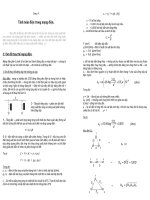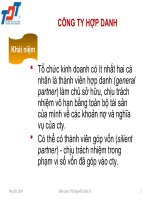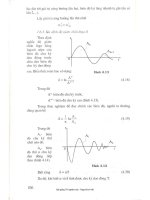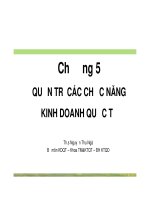Bài giảng môn MARKETING PRINCIPLE LECTURE NOTES: Chapter 5 1 consumer behavior in business market
Bạn đang xem bản rút gọn của tài liệu. Xem và tải ngay bản đầy đủ của tài liệu tại đây (124.84 KB, 6 trang )
9/21/2017
Business Markets and Business
Buying Behavior
Topic Outline
•
•
Chapter Six
•
Business Markets and Business
Buying Behavior
Copyright © 2009 Pearson Education, Inc.
Publishing as Prentice Hall
Chapter 6- slide 1
Business Markets
•
Define the business market and explain
how business markets differ from
consumer markets
Identify the major factors that influence
business buyer behavior
List and define the steps in the business
buying-decision process
Compare the institutional and
government markets and explain how
institutional and government buyers make
their buying decisions
Copyright © 2010 Pearson Education, Inc.
Publishing as Prentice Hall
Chapter 6- slide 2
Business Markets
Market Structure and Demand
Business buyer behavior refers to the
buying behavior of the organizations
that buy goods and services for use in
production of other products and
services that are sold, rented, or
supplied to others. Also included are
retailing and wholesaling firms that
acquire goods to resell or rent to others
for profit.
Copyright © 2010 Pearson Education, Inc.
Publishing as Prentice Hall
Chapter 6- slide 3
Fewer and larger buyers
Geographic concentration
Derived demand
• Inelastic demand
• Fluctuating demand
Buyer and seller dependency
Copyright © 2010 Pearson Education, Inc.
Publishing as Prentice Hall
Chapter 6- slide 4
9/21/2017
Business Markets
• More decision participants
• More professional purchasing effort
Copyright © 2010 Pearson Education, Inc.
Publishing as Prentice Hall
Chapter 6- slide 5
Business Markets
Types of Decisions and the DecisionMaking Process
Supplier development is the systematic
development of networks of supplier-partners
to ensure an appropriate and dependable
supply of products and materials that they will
use in making their own products or resell
Copyright © 2010 Pearson Education, Inc.
Publishing as Prentice Hall
Chapter 6- slide 6
Business Buyer Behavior
Business Buyer Behavior
Major Types of Buying Situations
Major Types of Buying Situations
Straight rebuy is a routine purchase decision
such as reorder without any modification
Modified rebuy is a purchase decision that
requires some research where the buyer wants
to modify the product specification, price,
terms, or suppliers
New task is a purchase decision that requires
thorough research such as a new product
Copyright © 2010 Pearson Education, Inc.
Publishing as Prentice Hall
Chapter 6- slide 7
Systems selling involves the purchase of
a packaged solution from a single seller
Two-step process of selling:
– Interlocking products
– System of production, inventory control,
distribution, and other services to meet the
buyer’s need for a smooth-running
operation
Copyright © 2010 Pearson Education, Inc.
Publishing as Prentice Hall
Chapter 6- slide 8
9/21/2017
Business Buyer Behavior
Business Buyer Behavior
Participants in the Business Buying
Process
Participants in the Business Buying
Process
Buying center is all of the individuals and
units that participate in the business
decision-making process
– Their relative authority
– What evaluation criteria each participant
uses
– Informal participants
– Users
– Influencers
– Buyers
– Deciders
– Gatekeepers
Copyright © 2010 Pearson Education, Inc.
Publishing as Prentice Hall
• Buying center provides a major
challenge
• Who participates in the process
Chapter 6- slide 9
Copyright © 2010 Pearson Education, Inc.
Publishing as Prentice Hall
Chapter 6- slide 10
Business Buyer Behavior
Participants in the Business Buying
Process
Users are those that will use the product or
service
Influencers help define specifications and
provide information for evaluating alternatives
Buyers have formal authority to select the
supplier and arrange terms of purchase
Deciders have formal or informal power to
select and approve final suppliers
Gatekeepers control the flow of information
Copyright © 2010 Pearson Education, Inc.
Publishing as Prentice Hall
Chapter 6- slide 11
Business Buyer Behavior
Major Influences on Business Buyers
Economic
Factors
Personal
Factors
Price
Emotion
Service
Copyright © 2010 Pearson Education, Inc.
Publishing as Prentice Hall
Chapter 6- slide 12
9/21/2017
Business Buyer Behavior
Business Buyer Behavior
Major Influences on Business Buyers
Environmental Factors
Major Influences on Business Buyers
Organizational Factors
Demand for
product
Economic
outlook
Cost of
money
Objectives
Policies
Resource
availability
Technology
Procedures
Culture
Structure
Politics
Copyright © 2010 Pearson Education, Inc.
Publishing as Prentice Hall
Chapter 6- slide 13
Business Buyer Behavior
Major Influences on Business Buyers
Interpersonal Factors
Motives
Perceptions
Preferences
Age
Income
Education
Copyright © 2010 Pearson Education, Inc.
Publishing as Prentice Hall
Chapter 6- slide 14
Business Buyer Behavior
The Buying Process
• Problem recognition occurs when
someone in the company recognizes a
problem or need
• Internal stimuli
– Need for new product or production
equipment
• External stimuli
Attitude
toward risk
Copyright © 2010 Pearson Education, Inc.
Publishing as Prentice Hall
Systems
Competition
– Idea from a trade show or advertising
Chapter 6- slide 15
Copyright © 2010 Pearson Education, Inc.
Publishing as Prentice Hall
Chapter 6- slide 16
9/21/2017
Business Buyer Behavior
The Buying Process
General need description describes the
characteristics and quantity of the needed item
Product specification describes the technical
criteria
Value analysis is an approach to cost reduction
where components are studied to determine if
they can be redesigned, standardized, or made
with less costly methods of production
Copyright © 2010 Pearson Education, Inc.
Publishing as Prentice Hall
Chapter 6- slide 17
Business Buyer Behavior
The Buying Process
Supplier search involves compiling a list of
qualified suppliers
Proposal solicitation is the process of
requesting proposals from qualified suppliers
Copyright © 2010 Pearson Education, Inc.
Publishing as Prentice Hall
Chapter 6- slide 18
Business Buyer Behavior
Business Buyer Behavior
The Buying Process
The Buying Process
Supplier selection is the process when the
buying center creates a list of desired
supplier attributes and negotiates with
preferred suppliers for favorable terms and
conditions
Order-routine specifications is the final
order with the chosen supplier and lists all of
the specifications and terms of the purchase
Copyright © 2010 Pearson Education, Inc.
Publishing as Prentice Hall
Chapter 6- slide 19
Performance review involves a critique
of supplier performance to the purchase
terms
Copyright © 2010 Pearson Education, Inc.
Publishing as Prentice Hall
Chapter 6- slide 20
9/21/2017
Business Buyer Behavior
Business Buyer Behavior
E-Procurement
E-Procurement
• Advantages
–
–
–
–
–
–
• Online purchasing
• Company-buying sites
• Extranets
Access to new suppliers
Lowers costs
Speeds order processing and delivery
Shares information
Sales
Service and support
• Disadvantages
– Can erode relationships as buyers search for new
suppliers
– Security
Copyright © 2010 Pearson Education, Inc.
Publishing as Prentice Hall
Chapter 6- slide 21
Institutional and Government Markets
Institutional markets consist of hospitals,
nursing homes, and prisons that provide
goods and services to people in their care
• Characteristics
–
–
Low budgets
“Captive” audience
Copyright © 2010 Pearson Education, Inc.
Publishing as Prentice Hall
Chapter 6- slide 23
Copyright © 2010 Pearson Education, Inc.
Publishing as Prentice Hall
Chapter 6- slide 22
Institutional and Government
Markets
Government markets tend to favor domestic
suppliers and require suppliers to submit bids
and normally award to the lowest bidder
• Carefully monitored
• Affected by similar environmental factors
• Good credit
• Non-economic factors
• Minority suppliers
• Depressed suppliers
• Small businesses
Copyright © 2010 Pearson Education, Inc.
Publishing as Prentice Hall
Chapter 6- slide 24









